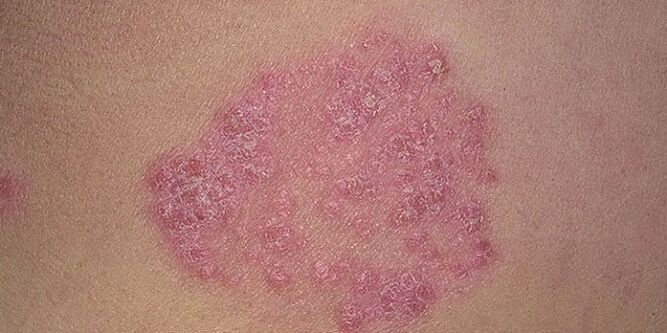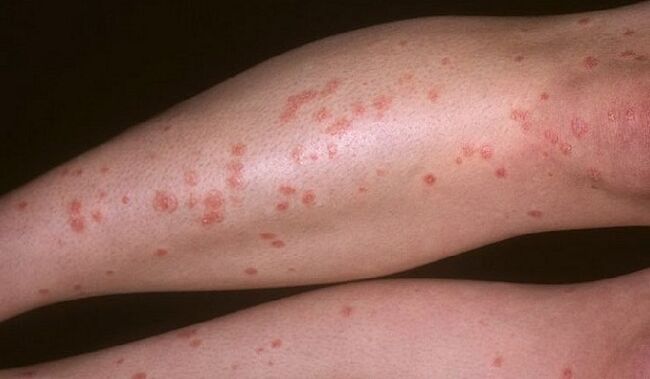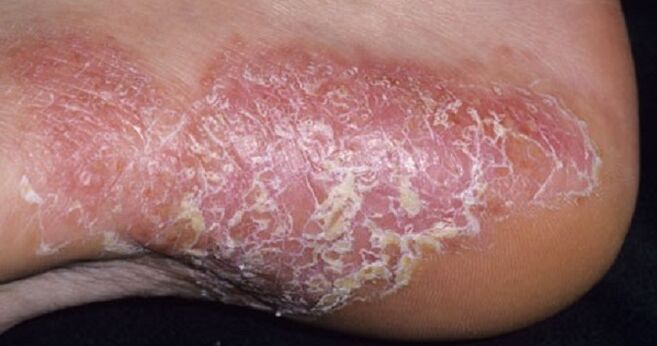Psoriasis of the legs is a skin disease in which itchy papules, spots, or pustules appear on certain parts of the limbs. Over time, they will grow and fuse into plaques. This disease is incurable and chronic. A well-designed comprehensive treatment helps to quickly relieve the symptoms of leg psoriasis. Therefore, if you want to get stable relief (completely or partially clear the skin of the rash component), you should not prescribe medication for yourself.
Pathological reasons
Scientists have not yet figured out why psoriasis occurs in the feet and other parts of the body. Many researchers have linked the psoriasis rash to genetic malfunction of epidermal cells and subsequent overactive immune system. This pathological condition occurs as follows:
- Due to skin dysfunction, keratinocytes (90% of epidermal cells) are too late to mature, but at the same time they multiply rapidly, which leads to structural changes in individual areas. skin.
- In response to this failure, the body's immune system sends T lymphocytes (killer cells) and macrophages (phagocytes) to destroy immature and pathologically altered keratinocytes.
- Due to the accumulation of a large number of immune cells and keratinocytes in the upper layer of the epidermis, the skin begins to grow and begin to fall off. No medicine can help to completely normalize the skin renewal function.
The progression of psoriasis on the legs is promoted by bacterial infections, which can penetrate the skin through small scratches, as well as hormonal background disorders, contact allergic dermatitis and many other external factors.
What psoriasis on the legs looks like depends on the type of disease
Psoriasis lesions on the feet and legs and knees may vary from person to person. This factor is explained by the periodic process of the disease. In addition, one or more forms of psoriasis may appear on the skin of the legs, including palmoplantar psoriasis, common psoriasis, teardrop psoriasis, punctate psoriasis, and nail and joint psoriasissick.
Psoriasis of the legs and feet
The components of a psoriasis rash can be located in different parts of the leg skin:
- On the knee
- On the calf
- On the heel
- In the thigh.
Psoriasis on the calves, feet, knee joints, and inner thighs begins with single red papules and severe itching (typically punctate and vulgar forms of the disease) or small pink and purple spots (teardrop psoriasis)).

In the first case, the composition of the rash is slightly higher than the surface of the skin, the density is different, and there are silver scales on the top, which will peel off when scratched with the nail. Over time, the pimples increase, and those pimples that are close to each other merge into one patch. As a result, they completely cover the skin of the knee or cover a solid area of skin from the knee to the foot. Exfoliation appears on the surface of the plaque.

In the initial stage, the teardrop-like component of the psoriasis rash affects the entire skin of the legs, with the same type of small rash. Then, as the disease progresses, individual spots merge into groups and cover large areas of skin on the legs. This psoriatic lesion rarely occurs on the heel.

Palmoplantar psoriasis usually occurs on the soles of the feet. The components of the rash appear on the inflamed skin of the feet in the form of small spots and pustules, with clear borders and yellow sterile contents. If the pustules on the legs open, the fluid inside will flow out, dry out and form yellow scabs, and the ulcers underneath will also dry up.
Pustules that do not rupture will be covered with dry scales. Gradually, they increase and combine into clumps, and the scaly layer begins to tighten the skin strongly, causing discomfort when walking. The skin around the plaque becomes thick, dry, and cracked. Through this crack, the infection usually penetrates into the deep layers of the dermis, and then the skin begins to weep and rot.
Psoriatic arthritis
In most cases, plaque psoriasis on the legs can cause psoriasis damage to the joints. This arthritis is divided into 5 types:
- Symmetry-the matching joints of the knees, hips, ankles, or feet are inflamed at the same time.
- Asymmetry-Pathological changes affect both large and small joints, for example, a knee joint and a toe joint.
- Distal joint inflammation-swelling of the small joints on the toes near the nails.
- Spondylopathy-Arthritis affects the lumbosacral spine, causing pain in the hips and lower limbs.
- Osteoarthritis is a rare inflammatory pathology in which the small joints of the fingers are completely destroyed.
The skin on the swollen joints swells, turns purple-blue and becomes hot.
Damaged nail plate
Psoriasis nail damage occurs in the following context:
- 80-90% of psoriatic arthritis;
- Crude or pustular psoriasis occurs in 50-60% of cases.
In 5-10% of clinical cases, toenail psoriasis is primary, that is, it appears spontaneously, with no previous psoriasis lesions of the joints or leg skin.
Initially, common psoriasis on the soles of the feet or psoriatic inflammation of the distal joints of the fingers can cause pathological changes in the skin of the periungual area. Then the pathology spreads to the nail bed or affects the nail plate lying on it. Deformation of the nails-formation of dents, horizontal lines-and discoloration of the plate.
Similar symptoms of female psoriasis are rarely observed in young people, and most commonly occur in young men. In old age, psoriatic nail damage affects women and men equally.
Progressive stage
If lower extremity psoriasis is not treated, it will go through 3 stages of development:
- initial;
- progress;
- stationary.
After that, the pathological changes paused and the remission phase began. Without preventive treatment, the disease will relapse over time.
The initial stage of leg disease is characterized by the formation of small single rashes in the form of spots, papules or pustules. At first, it can occur at the bends of both legs and knees at the same time. The components of the rash are red or pink, and then their tops are covered with white scales. The initial stage of psoriasis lasts about 3 weeks. During this period, papules or pustules enlarge and merge into clusters.
If you seek expert help in time, the initial stage of psoriasis can be stopped. But usually, people ignore the symptoms of the disease, which is why psoriasis continues to develop. In the progressive stage, the number of psoriasis plaques on the skin of the legs increases, and the plaques that are close to each other merge into "paraffin lakes" of various shapes and sizes. Psoriasis on the toes can cause inflammation and desquamation of the periungual tissue, and cause nail damage.
For the progressive phase, Kebner's phenomenon is characteristic, when a psoriatic rash is formed on the healed skin, for example, after a cut or scratch.
During the resting period, psoriasis on the feet and other parts of the legs still manifests as severe itching and flaking. However, the new elements of the rash no longer appeared, and the size of the plaque stopped growing. There is no edge of inflammation around them; dry scales appear in its place. If treatment is stopped at this stage, the deterioration of the disease will start again. Otherwise, the psoriatic plaques stop falling off, some of them disappear completely, some just brighten-the remission phase begins.
How to treat psoriasis on the legs
Taking into account the location of the rash, the form of the disease, the stage of progression, and many other factors, a treatment plan for leg psoriasis is prepared for each patient. Independently inventing a method to treat this disease is dangerous because complications can appear in the form of extensive skin damage, joint inflammation, up to its destruction and bacterial (staphylococcal, streptococcal) infections.
drug
First, the lesions of psoriasis are affected by non-hormonal ointments:
- Tar and naphthalene-ointment can relieve inflammation and are antiseptics, but they should only be used as directed by a doctor because they have serious contraindications.
- Sulfur salicylic ointment, salicylic acid-refers to a keratolytic agent (to destroy the stratum corneum). They have an exfoliating effect and help dissolve plaques.
- The ointment contains solidol, which softens the skin of the legs and has a regenerating effect.
- The ointment containing the active form of vitamin D3 slows the process of cell division, thereby reducing inflammation and peeling of the skin on the legs.
If non-hormonal drugs cannot help prevent psoriasis in the legs, a corticosteroid ointment is prescribed, which is divided into:
- Weak activity-funds act on the surface of the skin, suitable for the initial stage of psoriasis. Some ointments in this group are approved for use by children, pregnant women and breastfeeding women.
- Moderately active-used to treat psoriasis in rough skin areas of the legs, especially knees and soles of feet.
- Strong-If a medium-grade ointment does not prevent the increase of psoriasis plaques on the leg skin, prescribe it.
If the psoriasis ointment does not help, then in the advanced stage of the disease, the pill and topical medication are prescribed at the same time:
- Inhibit the activity of immune cells;
- Prevent the proliferation of epidermal cells;
- They also take retinoic acid-a derivative of vitamin A, which needs to restore epidermal cells.
How to get rid of psoriasis on the feet with home methods
The folk remedies for psoriasis are external and internal medicines, but they should be used with caution like medicines during treatment.
Questions such as how to completely cure psoriasis at home remain unanswered. Some homemade recipes help to eliminate the symptoms of diseases in the long-term, but they can't get rid of them completely.
Aggravating ointment
raw material:
- Unrefined sunflower oil-1 liter;
- Celandine herb-50 grams;
- Elecampane root-50 grams;
- Acetylsalicylic acid-50 tablets.
How to prepare: Use a coffee grinder to grind tablets and herbs, pour the resulting powder into vegetable oil, and mix thoroughly. Place in a warm, dark place for 30 days for injection. During this period, the mixture should be heated and stirred in the steam bath every 3 days, but not boiled.
Usage: filter the medicine, mix the resulting liquid with petroleum jelly (3: 1), and apply it to psoriatic plaques 3 times a day.
Ointment to relieve symptoms within 10 days
raw material:
- Birch tar-150 grams;
- Medicinal alcohol-150 mg;
- Camphor oil-75 mg;
- Egg yolks-3 pcs.
How to cook: Beat egg yolks in an enamel container, gradually add camphor, then add tar and alcohol. Store the ointment in a dark place.
How to use: Apply gauze pad to the inflamed skin of the legs. After three days, you need to wash your feet with warm water and tar soap foam, absorb the moisture and reapply the ointment for 3 days. If the disease does not start, repeat the process again and then clean the skin.
It is very important to maintain the body’s immunity during treatment with self-made ointment. For this, you can take 1 teaspoon per day by mouth. Sea buckthorn oil.
diet
Proper nutrition is one of the conditions for effective treatment of psoriasis, not only in the legs but also in other parts of the body. Medical scientists have concluded that allergic factors can lead to the progression of all forms of psoriasis, so allergic foods should be excluded from the menu first:
- egg;
- seafood;
- Natural honey
- Chocolate, cocoa;
- Grape;
- mutton;
- pork;
- chicken;
- Alcohol.
During this period, it is very important to give up sweet, spicy, salty and smoky foods-they will slow down the metabolism in the body. The menu should include dairy products, river fish, cereals, baked apples, vegetable oil, green beans, and carrots.

When a person only drinks one type of water, complete starvation for psoriasis is contraindicated.
During the exacerbation of leg psoriasis, doctors recommend to arrange a fasting day once a week, for example, eating only apples, kefir or boiled river fish.
physiotherapy
The answer to the question of how to treat leg psoriasis through physical therapy is very broad. To this end, the doctor prescribes the following:
- Ultrasound Therapy-Ultrasound from the device compresses and stretches the skin tissues. This is done to restore their cells. Therefore, inflammation, itching and swelling of the leg skin can be relieved.
- Electrosleep-If a person cannot cope with the stress caused by pathology, it is used for skin psoriasis of the legs.
- Light therapy-under the influence of ultraviolet rays, the skin's immunity is strengthened, and the speed of growth and cell division is reduced.
In order to improve the metabolic process of the skin of the psoriasis, acupressure is helpful. It is recommended to do it only during the remission of the disease, otherwise the inflamed skin is highly likely to be infected.
Hygiene rules
In order not to cause new psoriasis plaques on the skin of the legs, it is recommended to wash the skin only with warm water and moisturizing baby soap during the remission period. When the disease progresses, using warm water and tar soap to wash your feet can not only cleanse the skin, but also relieve inflammation. After washing, dry the skin and toenails thoroughly with a soft towel.
other suggestion
If a person has the following conditions, the treatment of leg psoriasis will be long-term:
- He is engaged in an active sport-his legs are sweating and he has a lot of load on his feet. After training, it is very important to wash your feet with warm water, dry them thoroughly, and put on clean socks and loose shoes to let your skin breathe.
- Tanning in the sun regularly and for a long time-excessive sunbathing can cause burns and damage the skin's metabolic processes. In the advanced stage of leg skin psoriasis, it is best to refuse a lot of sunbathing, and sunscreen should be used during the remission period.
Preventive measures and prognosis
Today, psoriasis is considered incurable. Therefore, once the symptoms continue to decrease, efforts should be made to maintain this condition in the manner recommended by the doctor. There is no place for self-medication.























